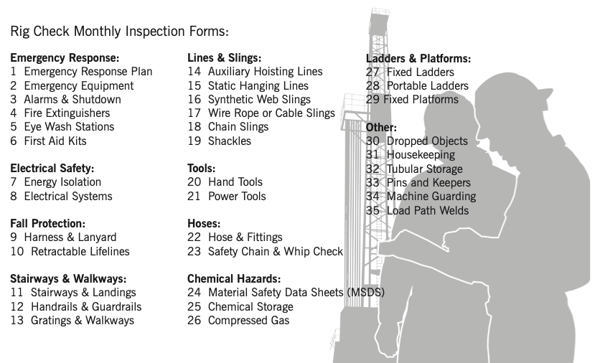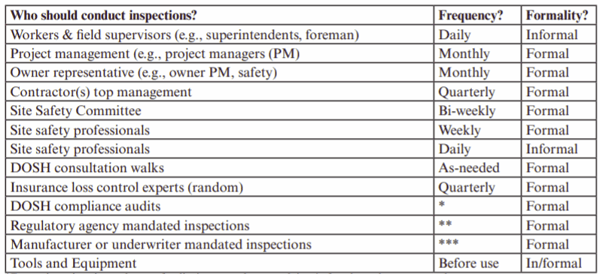
The history of the oil and gas industry is replete with numerous catastrophic events that have led to fatalities, environmental pollution, financial losses, and reputational damage. In many of these accidents, investigators have fingered poor communication of deficiencies as the number one contributing factor despite evidence of rig inspections.
In an effort to improve safety standards within the oil and gas industry, the National Institute for Occupational Safety and Health (NIOSH) created Rig Check - a comprehensive auditing and inspection process consisting of 35 forms. The inspection form includes instructions and is designed to adhere to relevant federal regulations, with a focus on enhancing the safety of rotary and workover rigs. The aim of Rig Check is to standardize equipment assessment and promote overall health and safety across the industry.
 (Image source: cdc.gov)
(Image source: cdc.gov)
Despite the apparent benefits of NIOSH's Rig Checks, the process of manual evaluation and recording creates accuracy problems. To resolve this issue, below are eight best practices to ensure compliance with NIOSH's rig inspection regulations and standards. Adhering to these practices eliminates errors and improves communication throughout your operations.
Check out the following examples:
- NOISH Rig Checklist Example - Chain Sling
- NOISH Rig Checklist Example - Energy Isolation Inspection Checklist
- NOISH Rig Checklist Example - Emergency Planning Inspection Checklist
- NOISH Rig Checklist Example - Power Tools Inspection Checklist
1. Develop a Drilling Rig Audit
The primary objective of a drilling rig audit is to comprehensively review workplace conditions, encompassing tools and equipment, and fittings safety chain. This is done to enhance health and safety standards and align with industry regulations as stipulated by NIOSH. Referred to as drilling rig inspections, these audits encompass the evaluation of rig equipment, tools and equipment, and the condition of fittings safety chain.
They also extend to the assets of drilling contractors within the gas extraction industry. These audits are conducted to assess and report on the overall condition of the rig. Throughout this process, strict adherence to industry-recommended practices and any additional internal standards established by the company, especially due to the specialized nature of the work, is essential. Inspectors may employ an inspection form to meticulously document their findings during the audit.
2. Communicate and Define the Audit’s Purpose
Communicate the audit’s purpose to all rig workers and define the scope this process entails. Develop a Site-Specific Safety Plan (SSSP) and communicate it to all employees to prepare for the audit process. The SSSP contains the objectives of the audit process and monitors the effectiveness of the exercise.
3. Establish the Rig Audit Needs
Once you identify your inspection needs, develop inspection tools to record findings. Three things will inform your inspection needs, they are:
- The company requirements to confirm the inspection needs
- Specific regulatory expectations
- Manufacturer equipment specifications and safety recommendations
4. Prepare and Plan for Inspections
The first step in planning for rig inspections is to ensure that rig auditors are specially trained individuals with industry knowledge in conducting adequate and accurate rig inspections. Rig audits are conducted to comply with federal regulations and industry standards. They are formal processes where inspections occur at specific intervals through a standardized, industry-approved procedure. This procedure is designed to assess equipment commonly found in the gas extraction industry, including fittings safety, lanyard retractable lifelines, and stairways. In addition to these formal assessments, workers perform daily informal evaluations while on the job.
Below is a general template for planning inspections:

(Image source: agcwa.com)
5. Implement Drill Inspection Checklists
Once you establish the scope of your rig audit process, the next step is to organize checklists and any other tools required to fulfil this process. Rig checklists or forms provide a standardized method of recording findings from an inspection exercise. They're made up of 35 sub-categories that rig inspectors use to assess the safety and quality of drilling operations equipment and working conditions.
Read How to create an Oil and Gas Walkthrough Inspection Checklist
Inspection checklists cover the following nine categories:
- Emergency Response: there are 6 checklists in this category – emergency response plan, emergency equipment, alarms and shutdown, fire extinguishers, eyewash stations, and first aid kits
- Electrical safety: 2 checklists for energy isolation and electrical systems
- Fall protection: 2 checklists to ensure harnesses, lanyards, and retractable lifelines meet the safety standards
- Stairways and walkways: 3 checklists that cover stairways and landings, handrails and guardrails, gratings and walkways
- Lines and slings: to ensure hoisting lines, wire rope, shackles, and slings work properly
- Tools: 2 checklists to assess hand tools and power tools safety
- Chemical hazards: to ensure compressed gas and chemicals are stored safely without any leakages
- Ladders and platforms: to evaluate quality and sturdiness of ladders and fixed platforms
- Other categories: the NIOSH checklists also review housekeeping, tubular storage, pins, and keepers, machine guarding, load path welds, and dropped objects
Inspectors manually fill in the checklists above, reviewing the information and submitting safety recommendations to the client. Though rig checks improved safety in the oil and gas industry, the manual process of recording inspection findings creates more complications due to inaccuracies, false information, and even forgeries. As a result, companies are now automating the inspection process to capture data in real-time and reduce report errors.
6. Conduct Regular Drilling Rig Maintenance
Conducting rig maintenance ensures critical equipment is safe to operate and in good working condition. Each project, company, and industry has specialized rig maintenance procedures customized according to manufacturer recommendations, equipment design, and industry regulation. A well-designed rig maintenance policy covers the following components:
- Drilling lines
- Engines, generators and motors
- Hoisting equipment
- Swivel joints
- Mud circulation systems
- Water and fuel tanks
- Drill bits
- Diesel, pneumatic or hydraulic components
- Security features and provisions
7. Automate Inspection Checklists
Manual inspection forms require thorough scrutiny, while hanging lines and cable slings play critical roles in various operations. Lanyard retractable lifelines stairways serve as vital safety equipment, and stairways are common pathways. All of these elements are susceptible to errors that, if left unaddressed, can lead to delayed deficiency reporting, breakdowns in communication, the creation of falsified reports, and, in some cases, fatal injuries when control equipment is not promptly attended to.
Invest in Appropriate Personal Protective Equipment (PPE)
A major factor in determining workplace safety is if workers have the right PPE. Three out of five workplace injuries were due to workers not wearing PPE such as safety goggles, gloves, and head protection. Inspectors will flag your company’s operations if workers fail to wear the right PPE or use no PPE at all - even if your rig and drilling systems are in good condition. Get safety experts to advise you on what PPE is required for the different sections of your facility.
Streamline Rig Inspections with FTQ360
FTQ360 has the complete library of NIOSH rig checklists and has gone further to integrate the forms into the FTQ360 application. Our quality assurance software gives you a platform to perform inspections, add images, notes and share findings with all stakeholders in real-time. There are no manual forms, and all information captured remains confidential and free of errors. Get in touch with us today to start your free trial.
![[DOWNLOAD THIS GUIDE TODAY] HOW INSPECTION APPS ARE DRIVING DIGITAL TRANSFORMATION IN THE OIL & GAS INDUSTRY](https://no-cache.hubspot.com/cta/default/3353989/8b58e27f-154e-49a2-beaa-d972aede0717.png)
